Cracking the Code
The REG Large Yacht Code forms the foundation of safe construction in the new-build sector. Here, we look at the 2024 revisions…
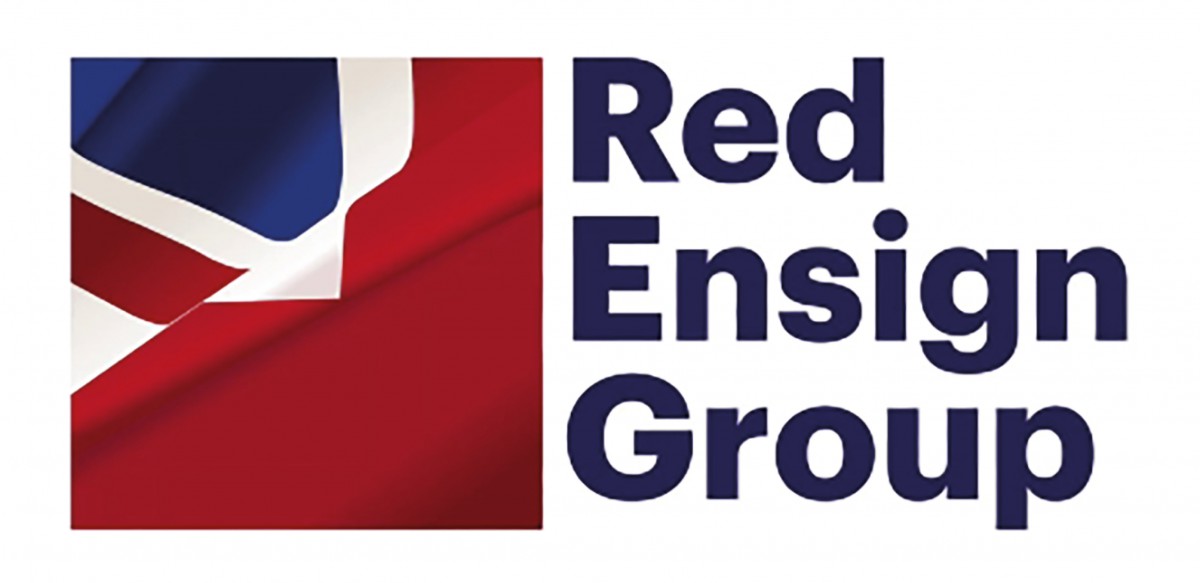
The Red Ensign Yacht Code was unveiled at The Superyacht Forum 2017 to consolidate expertise gained from the construction and operation of an increasingly diverse superyacht fleet. Twenty years after the Red Ensign Group (REG) published the influential Code of Practice for the Safety of Large Commercial Sailing and Motor Vessels, or LY1, the REG Yacht Code responded to the evolving needs of the fleet.
The collective Flag registries that comprise REG set some of the principal regulatory underpinnings of new-build design and construction.
The pace of change within the sector has only increased since then, with designers and shipyards striving to meet the demanding expectations of discerning clients while also addressing the growing impact of restrictive regulations. The pivotal role of Flag and Class in ensuring the safe construction of the next-generation fleet has gained further significance as they adapt to this rapidly changing market.
The comprehensive overhaul of the yacht code resulted from a two-year collaboration, marked by multiple industry consultations. These included well-supported working group meetings held across Europe and the UK between 2022 and 2023. The process involved active participation from a wide array of stakeholders, totalling 153 entities spanning REG administrations, classification societies and representatives from industry associations, naval architects, management companies and shipyards.
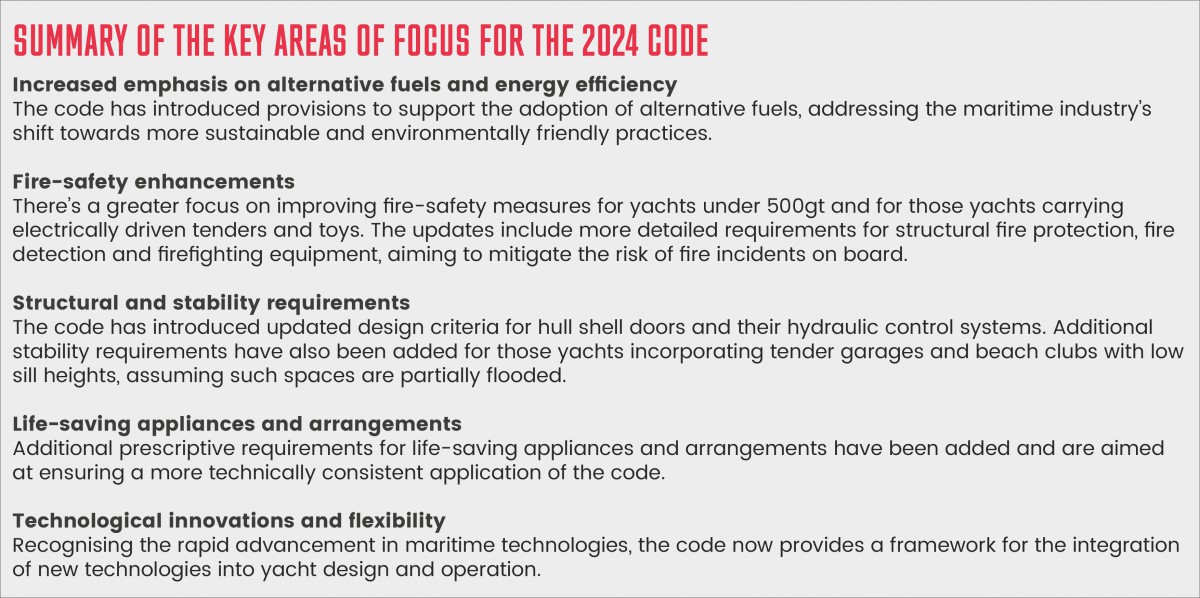
According to the Red Ensign Group, this effort aimed to underscore a commitment to inclusivity, ensuring that every sector of the industry not only provided input but also played a pivotal role in shaping the code. Among the main architects of the updated code were Andy Hinshaw from the UK Ship Registry, Carlo Vinelli, senior surveyor at the Isle of Man Ship Registry, and Julian Smith, principal surveyor and current REG Yacht Code Secretariat from the Cayman Islands Shipping Registry.
“Sometimes the brief and requirements from a designer clash with the technical regulations,” says Hinshaw. “This necessitates a reactive code and one that needs to be updated in response but which stays in keeping with our fundamental commitment to safety.”
“We have several driving factors necessitating amendments to the code,” says Smith. “These include emerging regulations published by the IMO affect-ing various technical requirements, changes in current thinking and trends in terms of design and construction of large yachts, and areas in the code that previously did not fully address technical issues affecting safety and pollution prevention.”
“The number of yachts subject to novel design approvals is growing every year,” says Vinelli. “If we look back 15 years, for example, yachts were quite standard comparatively.” Today’s new builds not only incorporate new technologies, but also adopt a new aesthetic, often necessitating a reassessment of safety standards and the application of the yacht code.
Increased emphasis on alternative fuels is a reaction to a small but growing demand from certain projects. Vinelli explains, “We have seen an increase in inquiries about the uptake of alternative fuels like methanol and hydrogen in new builds. The challenge of educating owners about the benefits and feasibility of adopting these technologies is still an issue, but we are working to ensure the code can help with the transition.
“Technical consistency is something we take very seriously. We recognise the importance of ensuring that we provide a level playing field to the industry and avoid inadvertently placing one shipyard at a commercial disadvantage due to slight variations in how the code is applied.”
Alongside broader refinements of the code, the 2024 update has addressed some highly specific and yacht-centric issues. A less obvious example of this regulatory adjustment is that of navigational bridge visibility, particularly for yachts under 55 metres. Unique and unconventional designs that alter the bridge position in a way that may restrict the viability of the helm station leave some yachts exposed to the generic satisfaction of the appointed surveyor, which may lead to very different interpretations. “This was not such an issue in the past, but we have had to adapt the regulations to bridge the gap for smaller yachts,” says Vinelli.
The increasing numbers of support yachts in the fleet and under construction have been some of the most conspicuous additions. According to Smith, these distinctive vessels have also presented a challenge to regulators. “These so-called shadow vessels have previously fallen into a grey area,” he says. “There has been some ambiguity as to whether these are merchant ships and what the requirements would be to qualify for a certificate under the yacht code.”
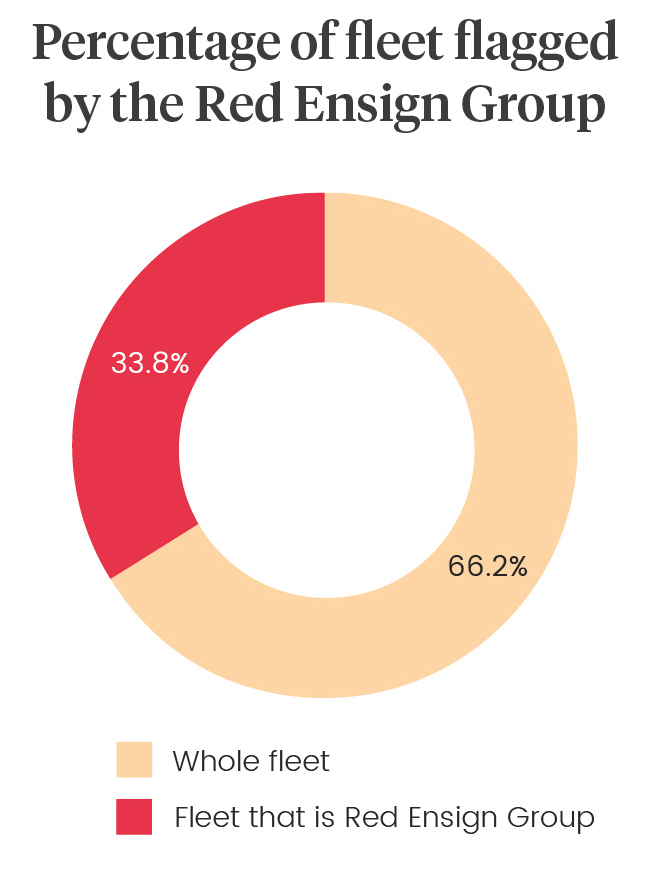
These vessels present a complex combination of features for regulators. They typically carry a wide range of high-risk items, various tenders with different fuels, multiple helidecks and hangars, as well as sophisticated diving equipment. Smith says, “We have provided some clear guidance under the code via simple definitions as to what qualifies as a support vessel and what they can carry on board.
“A good example regarding the scope of the code having been expanded is with respect to diving operations. We now have prescriptive requirements for both air and nitrox as well as hyperbaric decompression chambers. We have always had requirements for submersible craft, but underwater exploration is an area where we continue to see growing interest, so we have expanded the scope to ensure that such high-risk activities are properly addressed.”
The ‘short-range yacht’ option within the REG Yacht Code refers to provisions that allow yachts that do not comply with the requirements for unrestricted service to operate within specified geographical limits and weather restrictions subject to compliance with reduced criteria. In maritime regulations, ‘short-range’ operations often have implications for the design and safety equipment on board, acknowledging that yachts staying closer to shore or operating within certain areas aren’t expected to face all of the same risks as those navigating across open oceans.
“Based on feedback received from a wide-ranging number of industry stakeholders, we have extended the availability of the Short Range Yacht option from 300gt to 499gt subject to the provision of additional fire-safety measures, which I am confident will be well received,” says Smith.
The recent spate of fires on yachts, particularly those under 500gt with composite builds, has cast a spotlight on industry safety standards. Recognising the need for informed regulations, key industry players have leveraged underwriter data to guide their decisions, ensuring that any new measures consider their commercial viability. It’s a delicate balance between the technical and commercial impact, ensuring that an appropriate level of safety is implemented and maintained.
“It’s fair to say that the wider yacht industry has had a lot of bad publicity recently due to a number of factors, including the number of yacht fires,” says Smith. “While the reasons behind these fires are many, it was clear that we needed to react as Flag States.”
A pivotal change in the updated yacht code is the adjustment of compliance timelines, now pegged to the contract-signing date rather than the keel-laying date. This shift aims to grant shipyards a longer runway to ready themselves for new regulatory demands. This proactive measure ensures that the adaptation to updated standards begins earlier in the vessel’s construction journey.
However, to accommodate speculative builds – those initiated without a contract – the keel-laying date remains the reference for compliance. This nuanced approach balances the need for timely preparation with the diverse construction practices of shipyards.
The push for faster and smoother compliance processes is essential as yacht builders push the boundaries of modern yacht design. Of particular significance for regulators is the growing trend of expansive yacht glazing. This design choice, driven by the desire for greater visual connectivity with the ocean, presents complex challenges from structural and fire-safety perspectives.
“During a recent engagement with the ISO 11336 working group in Germany, the topic of glazing was a focal point, underscoring the need for new standards that can accommodate the increasing size and scale of glass features on yachts,” says Smith. “The trend towards more glass not only enhances aesthetic appeal, but also introduces complications that span thermal efficiency, structural design and fire safety, making the development of suitable glazing standards a critical area of focus.
“In the latest yacht code revision, the regulatory team has been particularly diligent in avoiding the introduction of rules that would apply retrospectively.” One clarifies that only a single retrospective requirement has been introduced, which concerns passenger yachts and involves the provision of a loading and stability instrument. This instrument is, however, already regarded as fairly standard on existing passenger yachts, so the impact is expected to be negligible.
“This code update aims to avoid the complications seen in the 2019 code update, which introduced several retrospective requirements that affected the industry,” explains Smith. “We believe that this foresight will ensure that the new regulations are forward-looking without disadvantaging the existing fleet.”
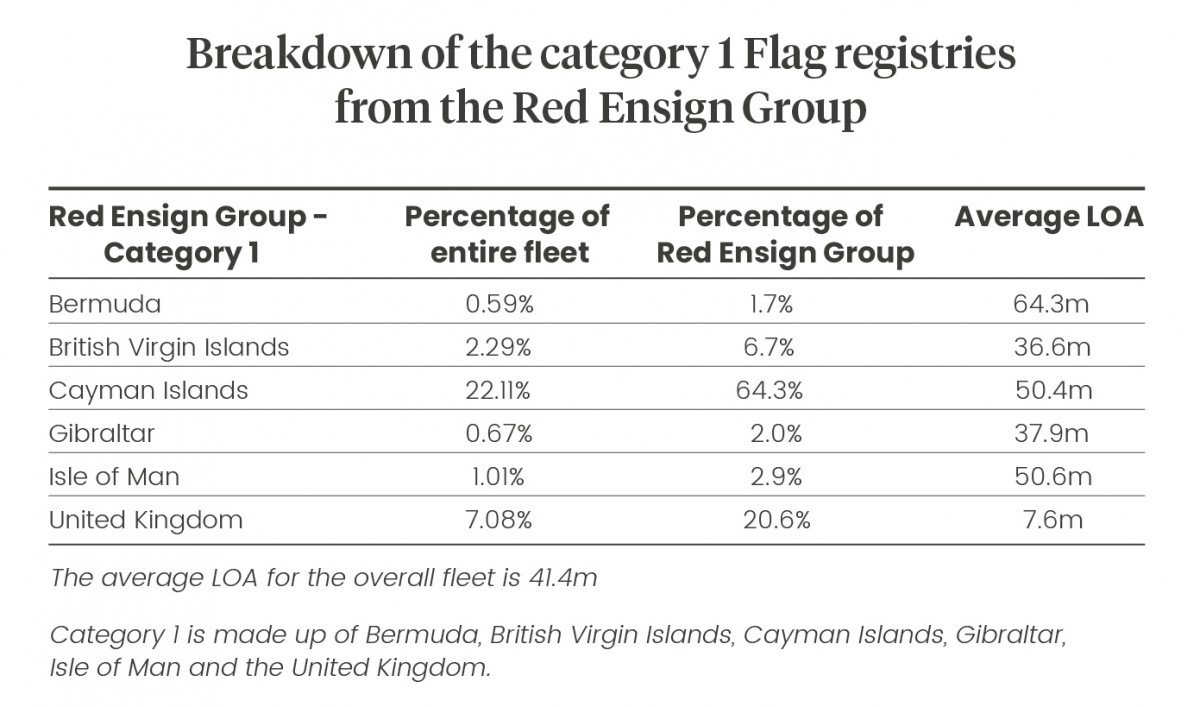
Looking further ahead to the next iterations of the code, REG sees a number of key areas that will likely be under additional focus in future. With several large-scale sailing-yacht projects currently underway, the technical demands of operating such vessels are significantly amplified for the smaller yachts. “The complexity of rigging on super-sized sailing yachts, particularly those exceeding the 100-metre mark, has become a focal point for the industry and an area of focus for us as Flag States,” says Smith.
The maritime industry’s pivot towards greener propulsion technologies mostly focuses on the bridging solution of diesel-electric systems complemented by substantial lithium-ion battery reserves. However, these steps, while progressive, still rely on traditional diesel fuel and do not fully resolve the issue. A more complete solution will need a rethink in the transition to methanol and other alternative fuels face significant hurdles, particularly in overcoming the energy density dilemma that these fuels present.
“The crux of the matter also involves educating yacht owners about operational expectations and refuelling logistics,” concludes Smith. “An integral part of this shift will be the development of a robust infrastructure to support new fuel types, a classic ‘chicken and egg’ scenario whereby the provision of facilities and the adoption of the technology are interdependent.”
The impact of these revisions extends far beyond compliance checkboxes and regulatory mandates. As the next-generation fleet evolves, so too, says REG, will the Large Yacht Code, and the 2024 revisions are illustrative of the ongoing evolution of safety and environmental standards within the new-build sector. Beyond the technical adjustments and regulatory tweaks, these revisions show a collective commitment to navigating the complexities of an ever-evolving legislative landscape.
At its core, the updated code reflects the delicate balance between tradition and progress – a testament to the industry’s ability to adapt, innovate and anticipate challenges on the horizon. Through collaborative efforts and forward-thinking initiatives, stakeholders have come together to shape this framework that not only meets regulatory requirements, but also embraces the spirit of responsible stewardship of the industry, serving as a clarion call for continued collaboration and dialogue across the superyacht community.
This collaboration will be paramount over the next few years, with further opportunities for code refinement, particularly with sailing-yacht rigging complexity and the transition to greener propulsion technologies already in the regulators’ crosshairs.
Education and infrastructure development will be crucial in facilitating this transition, ensuring that owners and builders are equipped to embrace new operational expectations in order for yachts to maintain their value and remain in compliance with changes that are yet to come.
The full version of the code is available now from the REG website and comes into force in July 2024.
This article first appeared in The Superyacht Report – New Build focus. To gain access to The Superyacht Group’s full suite of content, publications, events and services, click here to join The Superyacht Group Community and become one of our members.
Profile links
NEW: Sign up for SuperyachtNewsweek!
Get the latest weekly news, in-depth reports, intelligence, and strategic insights, delivered directly from The Superyacht Group's editors and market analysts.
Stay at the forefront of the superyacht industry with SuperyachtNewsweek
Click here to become part of The Superyacht Group community, and join us in our mission to make this industry accessible to all, and prosperous for the long-term. We are offering access to the superyacht industry’s most comprehensive and longstanding archive of business-critical information, as well as a comprehensive, real-time superyacht fleet database, for just £10 per month, because we are One Industry with One Mission. Sign up here.
Related news
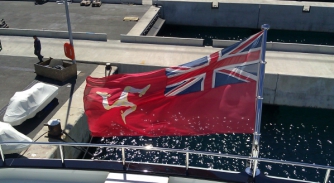
REG publishes revised Yacht Code
Released on 1 January, this revision from the Red Ensign Group represents the first major update since 2019
Business

The Malta model
Alison Vassallo discusses Malta’s plans to build a thriving superyacht jurisdiction as it moves to provide more than just regulatory frameworks
Business

REG gathers for Technical Forum
Red Ensign Group brings together expertise from across its members in Southampton from 7 to 8 March 2023
Business

Lloyd’s Register’s role as a trusted Class adviser
CEO Nick Brown explains how the global company wants to work with owners and stakeholders to find safe, reliable and sustainable solutions
Technology
Related news
REG publishes revised Yacht Code
2 years ago
The Malta model
2 years ago
REG gathers for Technical Forum
3 years ago
NEW: Sign up for
SuperyachtNewsweek!
Get the latest weekly news, in-depth reports, intelligence, and strategic insights, delivered directly from The Superyacht Group's editors and market analysts.
Stay at the forefront of the superyacht industry with SuperyachtNewsweek



